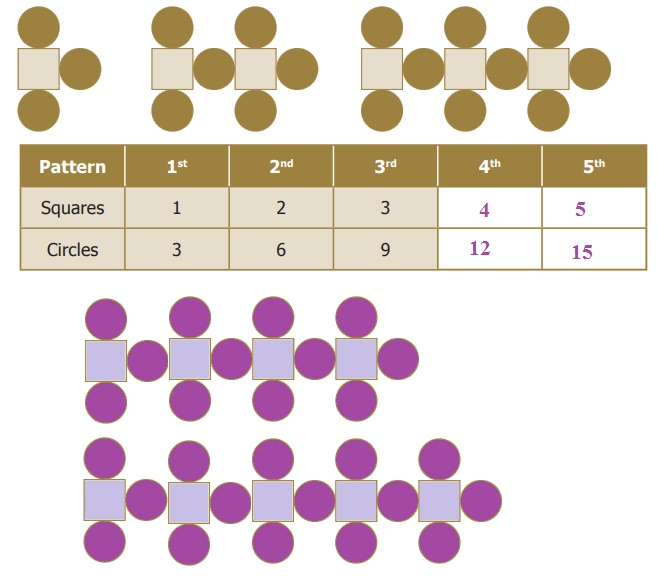Introduction to Algebra | Term 1 Chapter 2 | 6th Maths - Patterns | 6th Maths : Term 1 Unit 2 : Introduction To Algebra
Chapter: 6th Maths : Term 1 Unit 2 : Introduction To Algebra
Patterns
Patterns
Mathematics is easy when we look at it as a study
of patterns. Patterns allow us to make reasonable guesses. Understanding patterns
provide a clear basis for problem solving skills. In this chapter, we are going
to look at patterns that deals with numbers. For example, let us list the numbers
we know in order
1, 2, 3, 4, 5, 6, 7, 8, 9, 10...
We observe that 1 is odd, 2 is even, 3 is odd, 4
is even etc. Thus odd numbers and even numbers alternate with each other. If I tell
you that I have a sequence 12, 8, 4 … can you find the next number? Easy, each number
is obtained by subtracting 4 from the previous number. So the fourth number is 0.
The branch of Mathematics that deals with such patterns
is called Algebra. Today Algebra is used widely in many fields that include banking,
insurance, accounting, statistics, science, engineering, manufacturing and so on.
Try these
● Observe the following patterns and
complete them.
(i) 5, 8, 11, 14, ___ , ___ , ___
(ii) If 15873 × 7 = 111111 and 15873
× 14 = 222222 then what is 15873 × 21 = ? and 15873 × 28 =?
Answer: 15873 × 21 = 333333
Answer: 15873 × 21 = 444444
● Draw the next two patterns and complete
the table.

● Create your own pattern of shapes
and prepare a table.
1. Patterns in Number Operations
In the first chapter on Whole Numbers, you have
learnt about numbers that are multiplied by 1 or 0.
For example, we know, 57 × 1 = 57 and 43 × 0 = 0.
But we also know that this statement is true for all numbers (not just for the above two). So, can
we say “any number” × 1 = "the same number" that we started with?
Algebra gives a way for writing such facts in a
short and sweet way. We can write the above statement as n × 1 = n, where n is a number. Here n on the left-hand side is just a letter that is
used instead of saying "any number".
The number on the right-hand side is the same n. This ensures that we get a correct statement!
In Algebra, we say that “n” is a
variable. A variable is a symbol (usually an alphabet like
n or x) that represents a number. Variables often help us to write briefly
what we mean by a relation.
For example, the following patterns such as,
7 + 9 = 9 + 7
57 + 43 = 43 + 57
123 + 456 = 456 + 123
7098 + 2018 = 2018 +
7098
35784 + 481269841 =
481269841 + 35784
can be simply summarized as a + b = b + a.
Here, we have two variables namely “a” and “b”. Each variable can
take “any value”, but the value of ‘a’ is the same on both sides, and the value of ‘b’ is also the same on both sides. But, the values
of ‘a’ and ‘b’ need not be equal to each other.
Can you give a similar intrepretation for a × b = b × a ?
Note
Similar rules cannot be written for
subtraction! We know what is ‘7
− 3’, but not ‘3 − 7’.
So ‘a – b’ and ‘b − a’ are not the same!
Related Topics